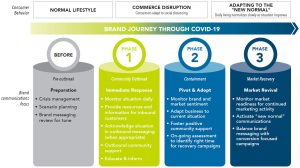We won’t be back to our pre-COVID normal world for a while, but we are now moving forward to our “new normal,” and we must respond accordingly. We can’t withdraw and cocoon, then expect our business to come out healthy on the other side.
During Q2, we were busy monitoring market sentiment and adapting our business through Phases One and Two of the current situation. Now, in order to activate recovery, we must adapt our strategy and assign marketing resources to Phase Three — Market Revival.
Here are the phases of our COVID journey:
- Pre-outbreak — Normal lifestyle
- Community outbreak — Commerce disruption
- Containment — Commerce disruption continues
- Market recovery — Adapting to the “new normal”

The good news is that the businesses that are agile and respond well will survive, and—in some cases—thrive. Having a brand recovery strategy to secure a spot in this group is key.
1. Be smarter than ever with your strategy.
- Start by re-visiting your pre-COVID business plan. To what extent does this model fit into the new normal? What adjustments need to be made, e.g. slowing business efforts in hard-hit sectors and doubling down in stronger ones? Would more diversification put you in a better place for future success?
- Do you have the right metrics to understand your business? Metrics that get you under the hood of your business and help describe how your business is operating always offer the business intelligence you need. And they are especially important now as we make our way through uncertain and rapidly changing times. What is your net revenue per employee and how is it changing? Which customers are most profitable and which ones require an inordinate amount of resources for their contribution to revenue? How has your cash on hand been affected?
- What needs to be improved in your business operations model to make it more efficient? For example, can you hold meetings with fewer people? Are there travel costs you can cut or processes you can automate? We just can’t carry inefficiencies or overspending in any way these days.
- Be agile! Agility and speed are critical to emergent strategies. We’re not in a situation where we can plan with high reliability too long into the future right now, so never before has a Plan B to complement your Plan A been more important. In fact, you may want to add a plan C in there. Begin by planning a quarter at a time, keeping your eye on how things unfold as you look to future quarters. We don’t know how the future economic climate will unfold, so we have to be flexible and responsive to what comes at us.
- Find the elusive balance between being defensive and aggressive. Being too defensive and focusing solely on cost cutting can make your business take on a siege mentality, restraining innovation and making decision-making too centralized, thereby inhibiting initiatives that may lead to post-recession growth. Being too aggressive purely based on a culture of optimism can lead to ignoring warning signs, overlooking realities and getting blindsided by poor financial performance. Find the elusive balance by understanding that while cost cutting is necessary to survive a recession, investing our resources properly is essential to emerge strongly. Adopt a combination of defensive approaches, such as workforce adjustments and operational efficiencies, with offensive ones, such as exploring new markets and investing in new initiatives.
- Remember that adversity creates opportunity to gain competitive advantage. Downturns offer an environment for progressive leaders to accelerate change. For example, the 2001 recession hit in the same year that Apple released its first iPod, but they forged ahead and increased their R&D spending by double digits. As a result, the iTunes music store and a new iPod were launched by 2003, sparking an era of huge growth.
2. Proactively communicate on the right channels.
- Focus on maintaining the relationship between you and your customers to make sure they are still there on the other side of this. This is particularly important with those who had services disrupted due to the crisis.
- Redouble your effort on producing excellent content and creative. People are hungry for news and information and they are turning to brands that can prove themselves trustworthy and helpful. You have a unique perspective around your expertise. Don’t waste it.
- Increase and maximize the use of your owned media to communicate your messaging. You have unfettered access to optimize the use of your social media channels, blogs, videos and website. Make the most of this opportunity to wow your audience with the great content you are creating.
- Explore using more virtual programming tools. Webinars and podcasts have become more popular, and new tools are making them easier than ever to produce. They have the added benefit of providing excellent opportunities to create “multipurposed” content with snippets for your social media channels. What may seem like one podcast could really be a podcast, a blog post, an email blast and five highlight snippets for social media.
- While marketing and advertising dollars are often the first thing to get cut in a recession, remember that this environment can be an opportunity for investment. The fact that most companies tend to cut back on advertising in a recession reduces noise in the marketplace and increases the effectiveness of advertising that is placed. When the economy expands as advertising spending goes back up and the clutter increases, the market mindshare gained during the recession will be maintained for those brands bold enough to invest in spending now.
3. Share the right messaging with your key audiences.
- People are craving normalcy now more than ever. While being respectful of our situation and not appearing tone-deaf is important, consumers are responding well to news that doesn’t focus solely on the crisis. Look for opportunities to put out positive back-to-business messaging.
- Consider a refinement in your brand positioning to reflect the current market environment. Focus on quality and value rather than status and/or luxury. Consumers will respond well to “fewer, better things” and “here’s to less” messaging. Debeers learned this during the 2008 recession when they stabilized their holiday business by associating high-quality messaging to their “A Diamond Is Forever” campaign.
- Leverage community. People are yearning for a sense of community now more than ever and are looking for ways to feel connected. Leverage the message of community connection that your brand can stand for to add a deeper layer of consumer attachment and trust. Communicate a message of “working for the greater good.”
- Be unique and personal in your creative messaging. Everywhere you turn, you hear and see verbal and visual messaging cut from the same cloth. Find a different way to express yourself. Nike is cutting through and drawing a direct tie to its brand with “If you ever dreamed of playing for millions around the world, now is your chance. Play inside. Play for the world.” Volvo is capitalizing on its safety brand essence with its “Safety Above Everything” tagline, urging everyone “Wherever you go, go safely.” The best advertising these days is tipping its hat to the crisis in a distinctive way and then moving on with more specific product copy.
- Be helpful and informative in longer-form messaging, such as your website, social media and blogs. If you are a healthcare brand, offer safety tips about how to avoid COVID-19. If you are in legal services, offer information about how to navigate unemployment and the Paycheck Protection Program. If you are in the auto business, promote the online buying process. Whatever your business is, there is a way to share your expertise and perspective in a valuable way.
- Clearly communicate the safety measures you are taking to keep people secure and comfortable doing business with you, but don’t shout it from the rooftops. Make this information easily accessible, but not overbearing.
With your recovery business operations and messaging plan in place, you will be in a place to move forward with finding your right communications balance. Be keenly aware of your audience and how you will speak with them. But don’t wait. Now is the right time to get your marketing and media rolling again.











